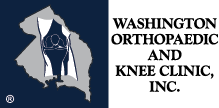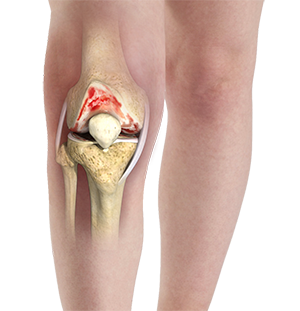
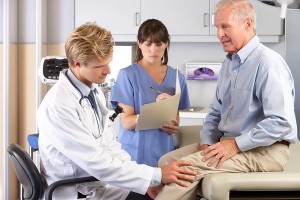
There are numerous types of arthritis and almost all of them has the potential to involve the knee joint.
The followings are the most common types of arthritis affecting the knee joint:
- Osteoarthritis (OA): Approximately 20 million Americans suffer from osteoarthritis. There can be many factors contributing to development of osteoarthritis including age, weight, occupation and heredity, but it is primarily a result of excess stress and resulting “wear and tear” on the knee joint.
- Rheumatoid arthritis: This is an autoimmune disease and generally affects individuals at a younger age. This disease may affect several joints in the body at the same time and can lead to significant deformities and functional disability.
- Psoriatic arthritis: This mostly is seen with individuals who suffer from psoriasis and can also involve more than one joint.
- Gouty arthritis: This type of arthritis is associated with gout and there is collection of uric acid crystals in the joint which can be destructive to the articular cartilage. In acute cases the joint involved will be warm, swollen and extremely painful.
- Septic (infectious arthritis): This condition usually is as a result of an infectious agent which has penetrated the knee joint and may be secondary to another infectious site in the body. Prompt attention to this condition, diagnosis and treatment may prevent further and long-term problems with the knee.
Since osteoarthritis is the most common type of arthritis, a more detail approach to diagnosis and treatment will be presented here.
Symptoms:
Pain, stiffness, occasional swelling and on severe cases deformities such as varus (bow legged) and valgus (knocked knee) may be present. There are some individuals with athletic injuries in which they have undergone surgery and removal of part or entire cartilage (meniscus) of the knee who may develop degenerative arthritis of the knee and usually are categorized with osteoarthritis although the cause has been different. In this situation usually only the injured joint is involved.
Diagnosis:
Usually, a plain x-ray film will identify the problem and rarely a Magnetic Resonance Imaging (MRI) will be needed. Some laboratory studies may be helpful specially to eliminate the other causes of arthritis such as rheumatoid arthritis.
Treatment:
Treatment of osteoarthritis is divided in two different approaches:
- Non-surgical
- Surgical
Non-surgical treatment:
1- Activity and lifestyle modification:
Avoiding aggravating activities, weight loss (very important) and modifying your
exercises to low impact (such as swimming and bicycling).
2- Exercises: These are generally is prescribed by physician for development of muscles
Around the knee (quadriceps and hamstrings) as well as their flexibility.
3- Anti-inflammatory medications:
These medications are divided into two categories:
- Steroidal (such as prednisone)
- Non-steroidal (such as ibuprofen)
These medications are prescribed to reduce the swelling and inflammation and to provide temporary relief of pain.
Non-steroidal medications (NSAIDs) also are divided to two categories:
Over the counter (OTC) and dietary supplements
Among the most commonly used are Tylenol (acetaminophen) and chondroitin sulfate/glucosamine complex. www.cosamin.com
Coxibs such as celecoxib (Celebrex) www.celebrex.com
This is s prescription medication designed to relieve the pain, inflammation, and stiffness of osteoarthritis. There are potential side effects as well as interaction with other medications. Those who are prescribed to take this medication need to ask questions in reference to side effects and interaction with other medications from their physicians.
Prescription (NSAIDs)
The more common prescription (NSAIDs) are the followings:
- Anaprox (Naproxen)
- Ansaid (Flurbiprofen)
- Arthrotek (Diclophenac combined with misoprostol)
- Celebrex (Celecoxib)
- Cataflam (Diclophenac)
- Clinoril (Sulindac)
- Daypro (Oxaprozin)
- Dolobid (Diflunisal)
- Feldene (Piroxicam)
- Indocin, Indocin, SR (Indomethacin)
- Lodine (Etodolac)
- Mobic (Meloxicam)
- Motrin (Ibuprofen)
- Nalfon (Fenoprofen)
- Naprosyn (Naproxen)
- Naprelan ( Naproxen)
- Oruvail (Ketoprofen)
- Ponstel (Mefanamic Acid)
- Relafen (Nabumetone)
- Tolectin (Tolmetin)
- Toradol (Ketorolac)
There can be side effects to these (NSAIDs) medications and those may include one or combination of the followings:
- Pain or gas in stomach
- Heartburn/indigestion
- Nausea
- Constipation
- Diarrhea
- Weight gain
- Fluid retention in lower legs and ankles
- Dizziness
- Ringing in the ears
- Ulcers
There may be other potential side effects, some minor and some serious.
Anti-inflammatory medications also come in a form of gel (Voltaren Gel) and or patches (Flector Patch).
4- Corticosteroid injection (Cortisone):
These are powerful anti-inflammatory drugs that are directly injected into the knee joint. Depending on the type of agent injected the result may vary. In case of successful outcome, the pain relief may last up to several months. It should be noted that this agents may have a detrimental effect on a normal articular cartilage.
5-Viscosupplementation:
Knee joint is being lubricated by synovial fluid which among other things contains Hyaluronan. In patients with osteoarthritis there is low concentration level of hyaluronan.
Presently there are five substances in the U.S. market who provide hyaluronan substitute to be utilized in patients with osteoarthritis.
These substances are as follows (alphabetically);
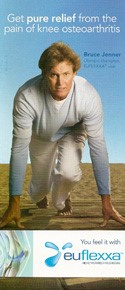
Euflexxa (Ferring Pharmaceutical)
www.euflexxa.com
Euflexxa is a Hyaluronic Acid (HA) which is bio-engineered and is the only non-avian product on the market.
It is injected directly into the knee joint by your doctor and is a total of three injections (one injection per week for three weeks).
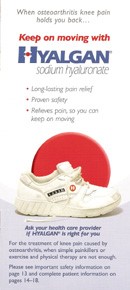
Hyalgan (Sanofi-Synthelabo)
www.hyalgan.com
Hyalgan (sodium haluronate) is a sterile mixture that is made up of a natural, highly purified sodium hyaluronate that comes from rooster combs.
This also is directly injected into the knee joint by your physician and is a series of three to five injection, once a week for three or five weeks.
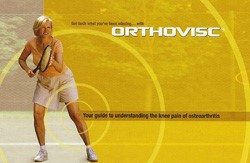
Orthovisc (Depuy Mitek)
www.orthovisc.com
Orthovisc is high molecular weight hyaluronan which is also directly injected into the knee joint by your physician. This is a series of three injections (once a week for three weeks).
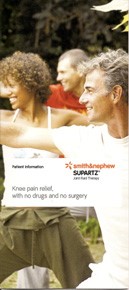
Supartz (smith & Nephew)
www.supartz.com
Supartz is a solution made of highly purified, sodium hyaluronate (hyaluronan or HA) which is injected into the knee joint by your physician for five weeks (one injection per week for five weeks).
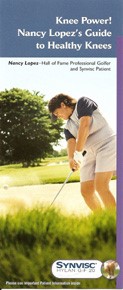
Synvisc (Genzyme Biosurgery/wyeth-ayerst laboratories)
www.genzyme.com
Synvisc (hylan G-F 20) is a viscous and elastic sterile mixture that is made up of hylan A fluid, hylan B gel, and salt water. The two hylans are manufacturesd from hyaluronan(sodium hyaluronate) that comes from chicken combs.
Synvisc is injected directly into the knee by your physician once a week for a total of three weeks.
Who should not be considered for this method of therapy?
- Those who are allergic to hyaluronate products.
- Those who are allergic to products from birds (poultry, feathers, eggs)
- Those with infection or skin diseases close and around the potential injection site.
- In the case of Euflexxa there will be no issue related to the chicken products since it is bio-engineered, however there may be individuals who are allergic to the material. In the case of infection and skin conditions close to the site of lesion precautions will be the same as other injectables.
Complications:
In most situations potential complications are mild and do not last long. These complications may include:
Pain, rash, swelling, warmth, itching, bruising/ and or redness. There may a transient sensation of being achy.
6- ACP (Autologous Conditioned Plasma) System:
Autologous blood products have created a growing interest for use in a number of orthopaedic conditions including early stages of degenerative and osteoarthritis of the knee. The healing effects of plasma are supported by growth factors released by platelets. These growth factors induce a healing process wherever they are applied.
Outside the bloodstream, platelets become activated and release proliferative and morphogenic proteins. These growth factors are known to be relevant for healing in a variety of tissue types including, bone, tendon, cartilage and skin. Their main action are:
- Induce proliferation and differentiation of various cell types such as stem cells, osteoblasts and epidermal cells
- Enhance/modulate production of collagen, proteoglycan and Tissue Inhibitor of Metalloproteinases (TIMP)
- Stimulate angiogenesis
- Chemotaxix
These benefits seem to involve synergistic effects of growth factors.
One example of these technique and utilization of which in orthopaedic conditions and in particular in early cases of degenerative or osteoarthritis is ACP system from Arthrex.
Features and benefits:
- The Arthrex ACP System is a cost –effective method of concentrating growth factors for therapeutic use. www.Arthrex.com
- Producing ACP (Autologous Conditioned Plasma) with the Arthrex ACP System can be performed within minutes. Typical platelet rich plasma (PRP) systems take up to 45 minutes to process the blood for application, thereby delaying treatment and increasing the cost of the procedure.
- The ACP System can be used in a clinic or under sterile conditions in an OR setting. The unique double syringe design allows for convenient and safe handling, as the whole preparation process takes place in a closed system.
The cost of the ACP System is more affordable than conventional PRP devices.
Find more at www.Arthrex.com
7- Bracing:
Knee bracing is proven highly effective in relieving osteoarthritis pain symptoms. Although this may be temporary but it is advisable especially in younger individuals where surgical options may be premature. These osteoarthritis braces (unloader braces) will apply pressure to the unaffected side of the knee to relieve the compressive forces in the affected side.
These braces can be used alone or in conjunction with other non-surgical treatments in patients with osteoarthritis.
Find more at www.sosortho.com
8-Arthroscopic surgery:
In some cases of osteoarthritis where there may be debris and breakdown products of degenerated cartilage and or degenerative tears of the menisci, then arthroscopic surgery will relieve the pain by removing and washing out the debris and removing the torn pieces of degenerated cartilage.
9- High tibial osteotomy (HTO)
10-Knee arthroplasty (Replacement)
